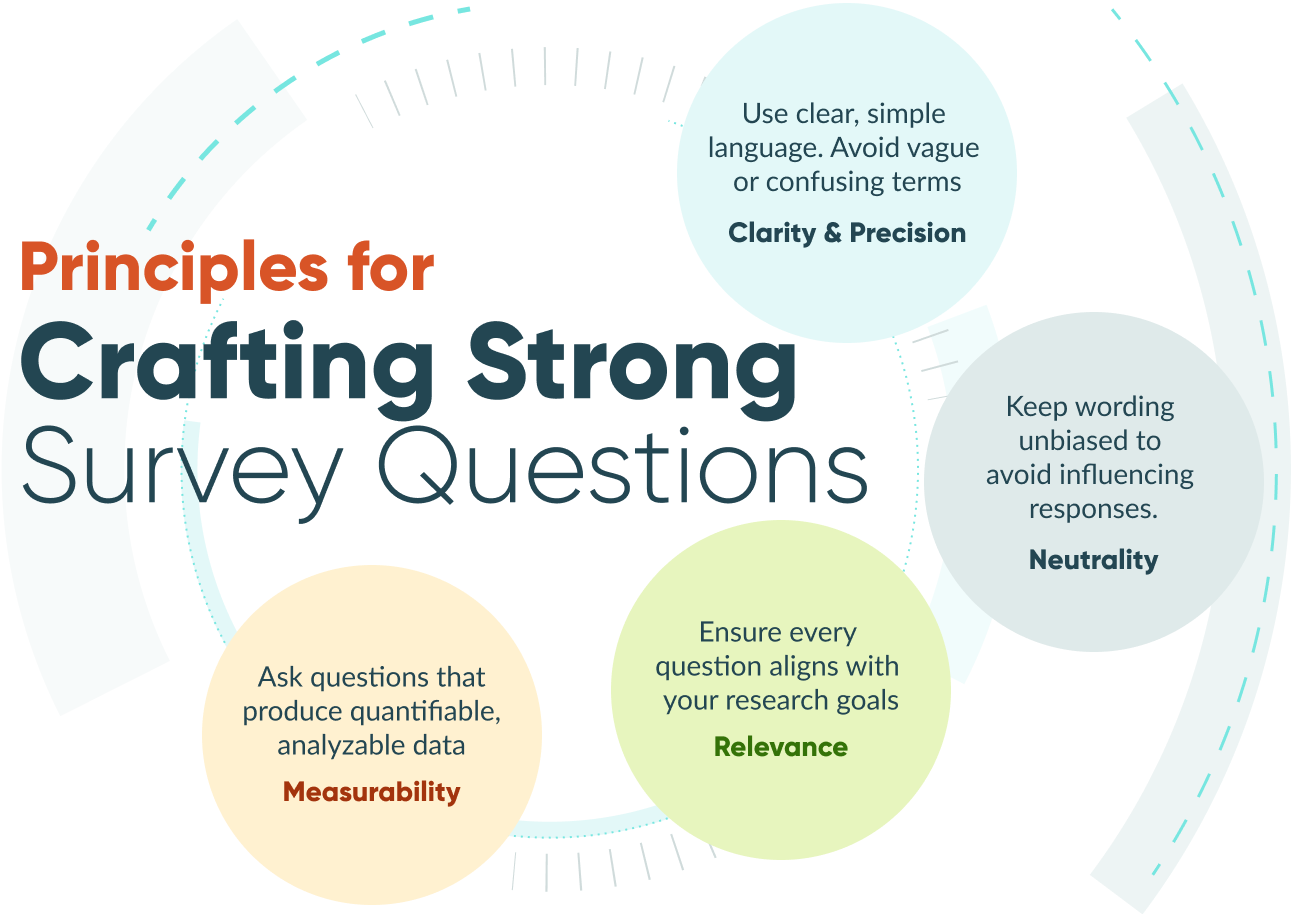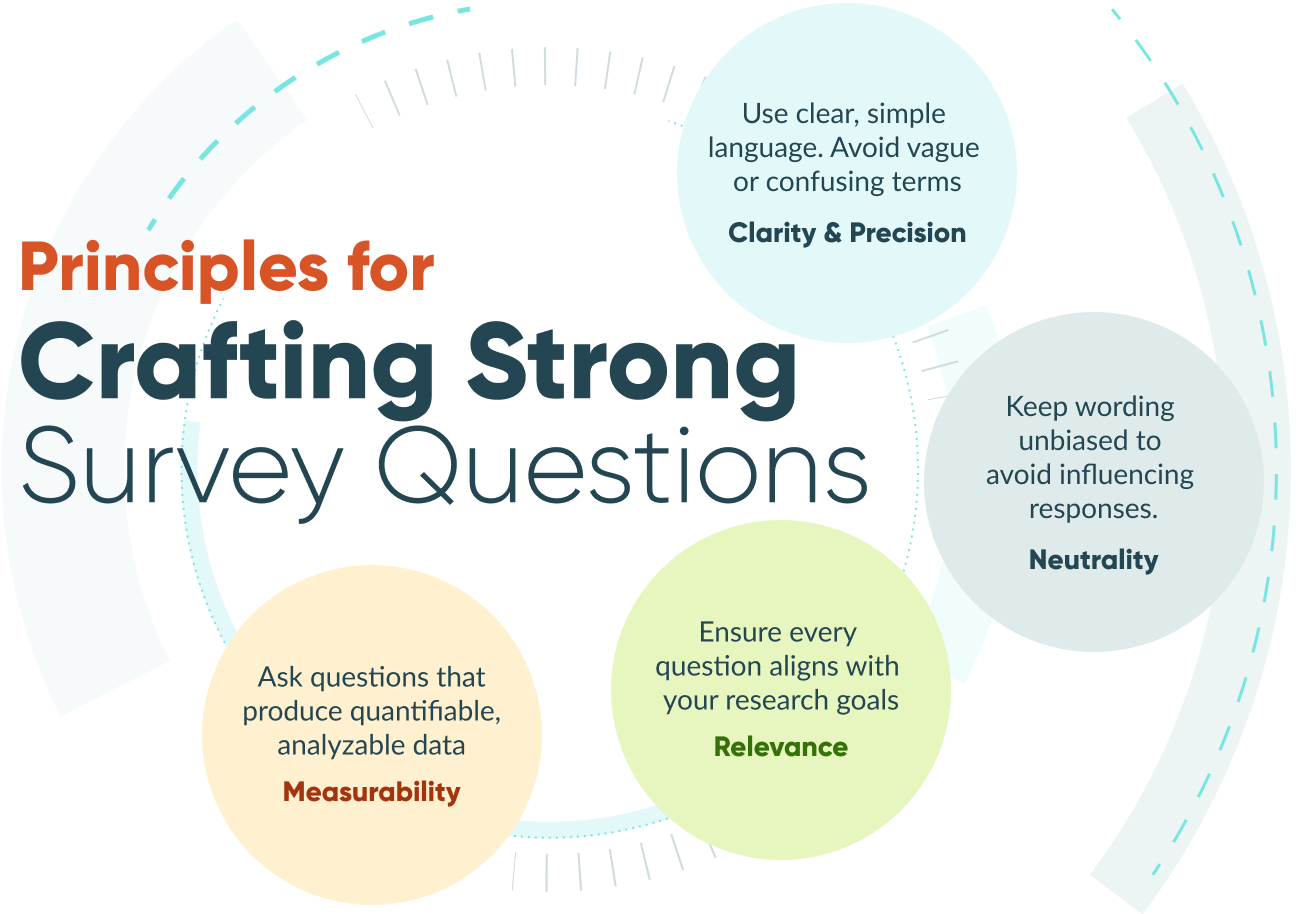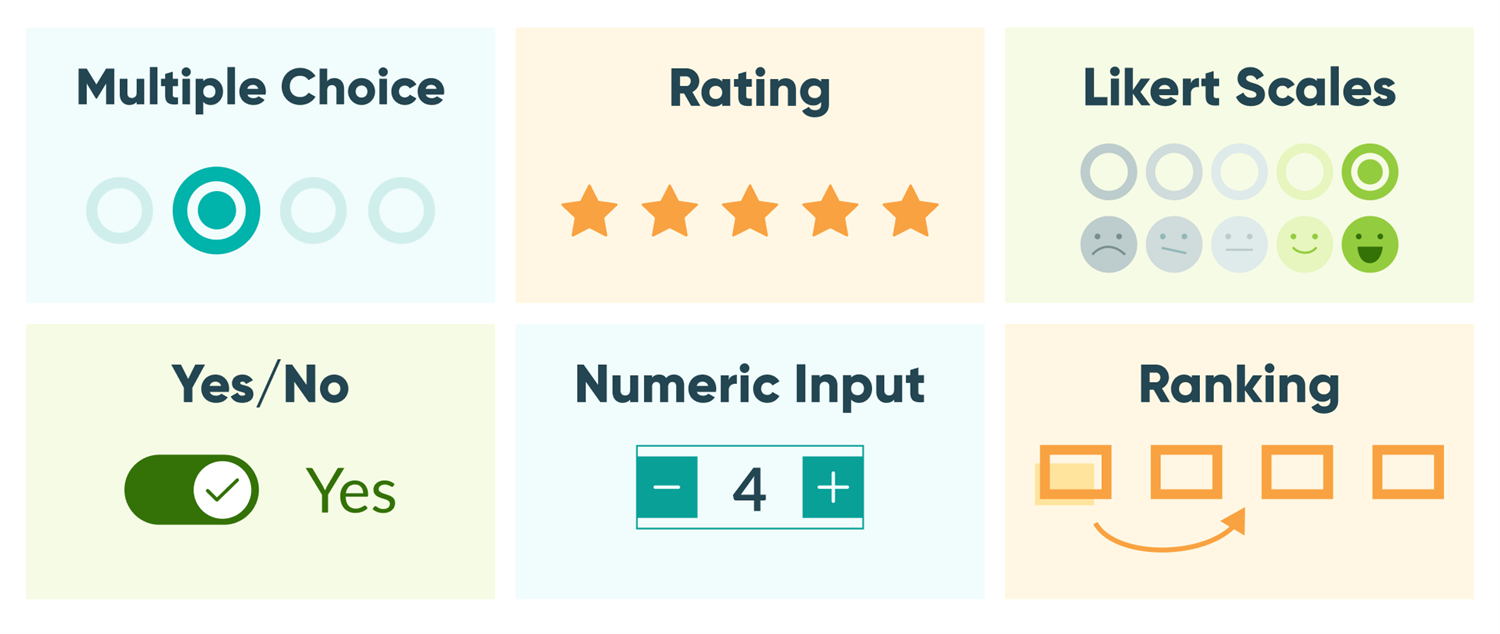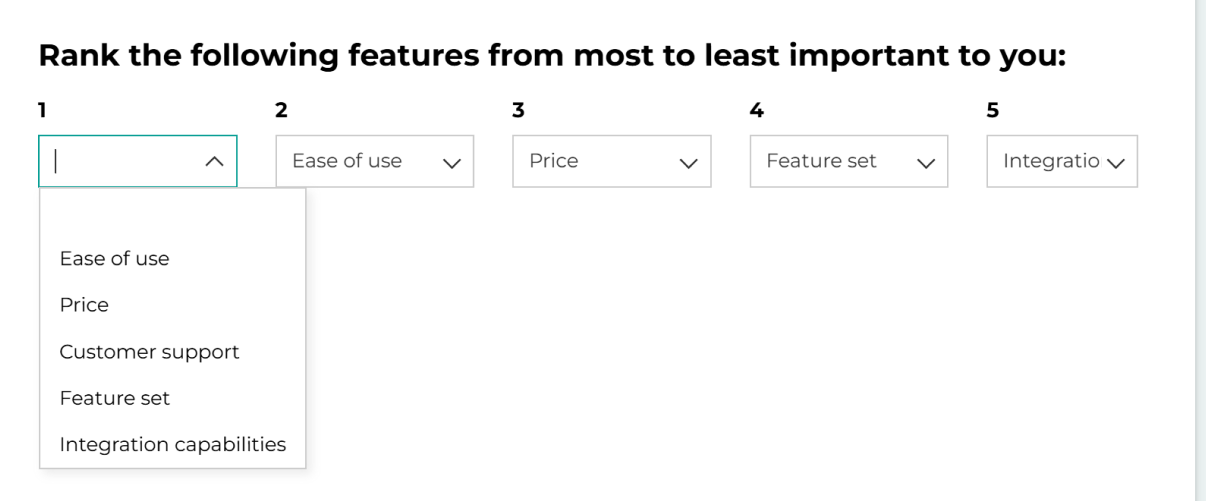Successful decisions aren’t made on gut instinct alone. They are built on solid, measurable evidence. Quantitative research surveys provide you with measurable and reliable insights.
Whether you are validating a new product, measuring customer satisfaction, or assessing team performance, quantitative research surveys provide the clarity needed to act.
Great data begins with asking great questions. Asking great questions, in turn, stems from well-defined research goals.
When your survey questions are carefully tailored to what you want to discover, you can:
- Capture data that can reveal trends
- Pinpoint areas for improvement
- Inform data-driven decisions
What Is a Quantitative Research Survey?
A quantitative research survey uses structured, closed-ended questions to collect numerical data from a targeted group of respondents. Its primary purpose is to measure variables, identify patterns, and generate statistically significant insights. These insights can be generalized to a larger population.
These surveys rely on closed-ended questions to ensure consistency and ease of analysis.
Each response is quantifiable, allowing researchers to apply mathematical and statistical techniques to interpret the results.
Crafting Effective Quantitative Research Questions


Before you can write individual survey questions, define the goal of your research and the specific quantitative research questions you aim to answer. A single research question often requires multiple survey questions to gather the necessary data from different angles.
There are four foundational principles that will help translate your research goals into clear, measurable, and unbiased survey questions.
Clarity and precision
Your questions should be clear, concise, and specific. Ambiguous wording can lead to unreliable data.
Unclear question: Do you contact customer support often?
→ This is unclear because the term “often” is subjective and may mean different things to different people.
Clear question: How many times did you contact customer support in the past month?
Measurability
Ensure your questions allow for quantifiable answers. The responses should be measurable on a defined scale.
Not measurable: How do you feel about our product?
→ This is not measurable because it invites open-ended and subjective responses that can’t be easily quantified or compared.
Measurable: On a scale of 1-10, how satisfied are you with our product?
Relevance
Your questions should directly align with your research objectives. Every question should serve a purpose in addressing your research goals.
Research question: Which communication tools do employees prefer for team collaboration?
Irrelevant question What’s your favorite way to end an email? a. Best b. Thanks c. Sincerely
→ This is irrelevant because, although it relates to communication, it doesn’t provide insights into tool preference or team collaboration methods.
Relevant question: What is your preferred communication tool when collaborating with teammates?
Avoiding bias
Use neutral wording to prevent leading respondents toward particular answers.
Biased question: How much did you enjoy our amazing new feature?
→ This is biased because it uses emotionally charged and positive language (“amazing”) that can influence the respondent’s perception.
Unbiased question: How would you rate your experience with our new feature on a scale of 1-5?
Connecting Your Questions to Research Goals
Writing strong survey questions begins with one essential step: clearly understanding what you want to learn. Without a well-defined goal, even the most carefully worded question can miss the mark.
Aligning your survey questions with your quantitative research goals leads to successful data collection.
Every quantitative research survey should begin with a specific research objective. Are you trying to describe behavior? Compare different customer segments? The answers to these questions will shape the types of survey questions you write and the data you collect.
When you start by identifying what you’re trying to understand, you can reverse-engineer your survey.
For each research goal you define, draft one core research question. Then, it will be broken down into 2-4 supporting survey questions that explore the issue from multiple angles. Then, choose formats and phrasing that will yield the data you need.
This layered approach enhances the reliability of your data and provides you with more comprehensive insights.
Example
Research question: What aspects of the customer support experience have the greatest impact on overall customer satisfaction?
Supporting survey questions:
-
On a scale of 1–10, how satisfied are you with the support you received during your most recent interaction?
→ This measures overall satisfaction directly and provides a benchmark for analysis. -
How would you rate the response time of our support team? (1 = Very slow, 5 = Very fast)
→ Evaluates a specific factor—timeliness—that could affect satisfaction. -
Did the support representative resolve your issue on the first contact? (Yes/No)
→ Helps identify whether first-contact resolution correlates with satisfaction. -
How would you describe the helpfulness and professionalism of the support representative?
(Very helpful and professional, Somewhat helpful, Neutral, Not very helpful, Not helpful at all)
→ Assesses the human element of the support experience.
Why this works:
These supporting questions break down the abstract idea of “satisfaction” into measurable components – speed, resolution, and interaction quality – providing actionable data that you can analyze both individually and collectively. By tying them back to the core research question, you ensure every question serves a strategic purpose.
Types of Quantitative Survey Questions


Choosing the right question format can significantly impact the quality and usability of your data.
Here are the most common formats for quantitative survey questions:
Multiple choice questions

Multiple choice questions offer respondents a fixed set of options to choose from. They’re easy to answer and analyze, making them ideal for gathering categorical data.
How it works
Provide a question with several predetermined answer options. Respondents select the one that best represents their answer.
Examples:
1. Which of our products do you use most frequently?
- Product A
- Product B
- Product C
- Product D
2. How did you hear about our company?
- Social media
- Search engine
- Friend/family recommendation
- Traditional advertising
- Other
3. Which department do you interact with most often?
- Sales
- Customer support
- Technical support
- Billing
- None of the above
4. What is your primary reason for using our service?
- Price
- Features
- Ease of use
- Customer service
- Brand reputation
5. Which feature would you most like to see improved?
- User interface
- Speed/performance
- Mobile compatibility
- Customer support
- Pricing options
Improving multiple choice survey questions
What to fix and why
Bad example: Don’t you think our new feature is better than the competition’s?
This is a leading question that biases the respondent by implying the feature is superior.
Improved version: How would you compare our new feature to similar offerings from competitors?
- Much better
- Somewhat better
- About the same
- Somewhat worse
- Much worse
Rating scale questions

Rating scale questions ask respondents to rate items on a numeric scale. They’re excellent for measuring satisfaction, agreement, or frequency.
How it works
Provide a statement or question and ask respondents to rate it on a numerical scale (commonly 1-5 or 1-10).
Example of rating scale questions
- On a scale of 1-10, how likely are you to recommend our service to others?
- Rate your satisfaction with our customer support from 1 (very dissatisfied) to 5 (very satisfied).
- How would you rate the ease of use of our platform? (1 = Very difficult, 5 = Very easy)
- Rate the value for money of our product: (1 = Poor value, 5 = Excellent value)
- How would you rate the speed of our website? (1 = Very slow, 5 = Very fast)
Improving rating scale survey questions
What to fix and why
Bad example: On a scale of 8-10, how great was our service?
This scale is skewed and limits responses to only positive feedback, making the data unreliable.
Improved version: On a scale of 1-10, how would you rate our service quality?
Likert scale questions

Likert scale questions measure attitudes or opinions by asking respondents to indicate their level of agreement with statements.
How it works
Present a statement and ask respondents to indicate their level of agreement (typically on a 5 or 7-point scale from “Strongly Disagree” to “Strongly Agree”).
Examples:
1. The onboarding process was straightforward.
- Strongly disagree
- Disagree
- Neither agree nor disagree
- Agree
- Strongly agree
2. I am satisfied with the features available in the current version.
- Strongly disagree
- Disagree
- Neither agree nor disagree
- Agree
- Strongly agree
3. The customer service team responds to inquiries in a timely manner.
- Strongly disagree
- Disagree
- Neither agree nor disagree
- Agree
- Strongly agree
4. The pricing structure is clear and transparent.
- Strongly disagree
- Disagree
- Neither agree nor disagree
- Agree
- Strongly agree
5. I would feel comfortable recommending this product to colleagues.
- Strongly disagree
- Disagree
- Neither agree nor disagree
- Agree
- Strongly agree
Improving likert scale survey questions
What to fix and why
Bad example: “Don’t you agree that our product is user-friendly?”
This is a loaded question that pressures respondents to agree rather than assess honestly.
Improved version: "Our product is user-friendly."
- Much better
- Somewhat better
- About the same
- Somewhat worse
- Much worse
Yes/No questions

Yes/No questions are straightforward binary questions that gather definitive answers.
How it works
Ask a simple question that can be answered with “Yes” or “No.”
Examples:
- Have you purchased from our company before?
- Did you find what you were looking for on our website today?
- Are you currently subscribed to our newsletter?
- Have you contacted our customer support in the past month?
- Would you be interested in beta testing new features?
Improving yes/no survey questions
What to fix and why
Bad example: You like our new interface, don’t you?
This question assumes a positive opinion and discourages honest negative responses.
Improved version: Do you find our new interface easy to use?
Numeric input questions

Numeric input questions ask respondents to provide specific numerical information.
How it works
Ask a question that requires a numerical response, such as age, frequency, or duration.
Examples:
- How many times have you used our product in the past week?
- How many employees work at your company?
- How many minutes do you spend using our app daily?
- What is your monthly budget for services like ours?
- How many years have you been in your current role?
Improving numeric input survey questions
What to fix and why
Bad example: How much do you use our product?
The question is vague and lacks a specific unit of measurement, making the answers difficult to analyze.
Improved version: On average, how many hours per week do you spend using our product?
Ranking questions

Ranking questions ask respondents to order items based on preference or importance.
How it works
Present a list of items and ask respondents to rank them according to specific criteria.
Examples:
1. Rank the following features from most to least important to you:
- Ease of use
- Price
- Customer support
- Feature set
- Integration capabilities
2. Rank your preferred methods of communication with our company:
- Phone
- Live chat
- In-app messaging
- Social media
3. Rank the following factors that influenced your purchase decision:
- Brand reputation
- Price
- Recommendations
- Features
- Customer reviews
4. Rank our product categories from most to least useful for your business:
- Category A
- Category B
- Category C
- Category D
5. Rank the following improvements in order of priority:
- Faster loading times
- More customization options
- Better mobile experience
- Enhanced reporting tools
- Improved user interface
Improving Ranking Questions
What to fix and why
Bad example:
Rank our amazing features in order of awesomeness:
- Magic Dashboard
- Superfast Sync
- Incredible Analytics
- Legendary Support
The wording is overly promotional and subjective, which undermines objectivity and clarity.
Improved version:
Please rank the following features in order of importance to your daily workflow:
- Dashboard for viewing and organizing data
- Real-time sync across devices
- Built-in analytics and reporting
- Customer support tools
Tips for Creating a Quantitative Research Survey
Creating a quantitative research survey that yields actionable data requires more than just good questions. Here are our top tips for success:
-
Start with clear objectives
Before writing a single question, define exactly what you want to learn. Every question should serve your research goals. -
Keep it concise
Respect your respondents’ time by including only essential questions. Survey fatigue leads to abandoned surveys and unreliable data. Don’t try to answer every research question with one survey. -
Use consistent scales
When using rating scales, maintain consistency throughout your survey (e.g., always use 1-5 or 1-10, but don’t mix them). -
Test your survey
Pilot your survey with a small group to identify confusing questions, technical issues, or logical problems before full deployment. -
Consider mobile users
Many respondents will complete your survey on mobile devices. Ensure your survey is mobile-friendly and easy to navigate on smaller screens.
How to Create a Quantitative Research Survey

Ready to create your quantitative research survey?
Follow these steps:
1. Define your research goals.
Clearly outline what you want to learn and how you plan to apply the information.
2. Identify your target audience.
Determine who needs to participate in your survey to provide relevant insights.
3. Select the right question types.
Choose question formats that will yield the data you need for analysis.
4. Draft your questions.
Write clear, unbiased questions that directly address your research objectives.
5. Organize your survey.
Arrange questions in a logical order, grouping related topics.
6. Build your online survey form.
Use Cognito Forms to create your survey with our intuitive drag-and-drop builder. Start with a template or copy your survey question into our AI form generator to have an editable draft in seconds.
7. Test and refine.
Pilot your survey with a small group and make necessary adjustments.
8. Distribute your survey.
Share your survey through email, social media, your website, or other channels.
9. Analyze your results.
Integrate your data with reporting tools, like Power BI, to analyze responses and identify patterns.
10. Act on your findings.
Implement changes based on your research results to improve your business.
Build Smarter Surveys with the Right Tools
Well-crafted quantitative research questions are powerful tools for gathering actionable data. The quality of your answers depends on the quality of your questions. By understanding the various types of questions and adhering to best practices for survey design, you can make informed decisions based on reliable data rather than assumptions.
To bring your survey to life, using an intuitive online form builder like Cognito Forms makes all the difference. With robust customization options, powerful conditional logic, and custom data collection features, Cognito Forms enables you to design professional, user-friendly surveys – no coding experience necessary.

